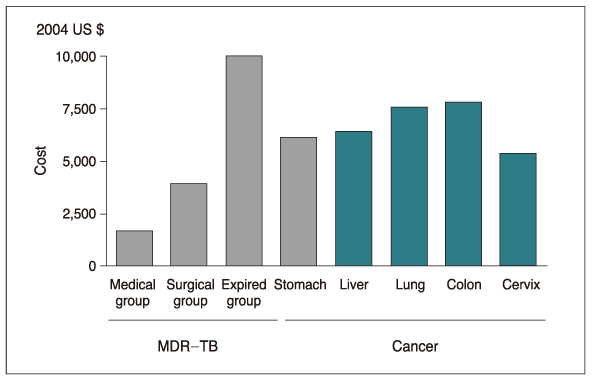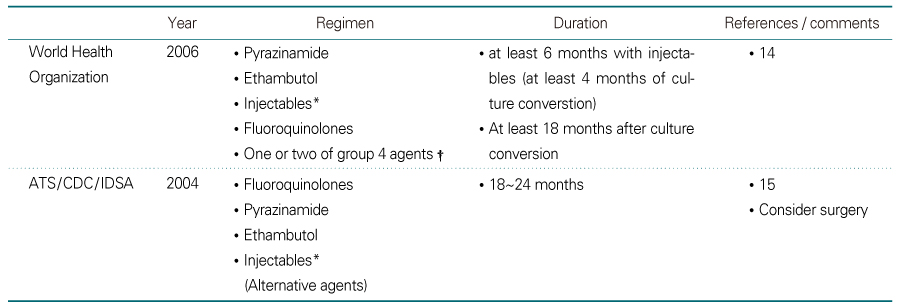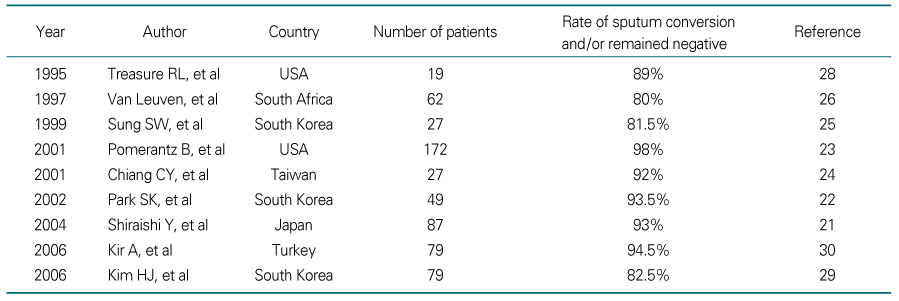 |
 |
- Search
| J Korean Med Assoc > Volume 49(9); 2006 > Article |
Abstract
Multidrug-resistant tuberculosis (MDR-TB), resistant to at least both isoniazid and rifampicin, poses a serious threat to global health because it requires treatment for a long duration and frequent hospitalization, and results in a considerable number of mortalities. According to a report from the World Health Organization in 2000, 3.2% of all new TB cases are MDR. In South Korea, multidrug-resistance was observed in 13% of re-treatment cases. The treatment of MDR-TB is difficult, since second-line drugs must be used, which are not as potent or as well tolerated as in the first-line drugs. Early publications on the treatment response of MDR-TB reported a considerable rate of mortality, as high as 37%. The use of 4 or 5 drugs including injectable drugs and fluoroquinolones is the fundamental of the medical treatment of MDR-TB. For patients with MDR-TB refractory to medical treatment, surgical resection could be tried. However, the candidate for the surgical resection should be selected cautiously. To overcome the low success rate of treatment among MDR-TB patients, well-designed clinical trials including newer drugs or regimens should be performed. MDR-TB has been a serious challenge to human health, especially in South Korea. To reduce the individual or social burden from MDR-TB, a commitment of government as well as clinicians is essential.
References
1. Dye C, Espinal MA, Watt CJ, Mbiaga C, Williams BG. Worldwide incidence of multidrug-resistant tuberculosis. J Infect Dis 2002;185:1197-1202.
2. Korean Center for Disease Control and prevention. Anti-tuberculosis durg resistance in Korea. Communicable Diseases Monthly Report 2005;16:101-107.
3. Kim BJ, Lee IH, Lee DH, Bai GH, Kong SJ, Park SK, et al. The current status of multidrug-resistant tuberculosis in Korea. Tuber Lung Dis (In Korean) 2006;60:404-411.
4. Mukherjee JS, Rich ML, Socci AR, Joseph JK, Viru FA, Seung KJ, et al. Programmes and principles in treatment of multidrug-resistant tuberculosis. Lancet 2004;363:474-481.
5. Kim HJ, Hong YP, Kim SJ, Lew WJ, Lee EG. Ambulatory treatment of multidrug-resistant pulmonary tuberculosis patients at a chest clinic. Int J Tuberc Lung Dis 2001;5:1129-1136.
6. Gupta R, Kim JY, Espinal MA, Caudron JM, Pecoul B, Farmer PE, Raviglione MC. Public health. Responding to market failures in tuberculosis control. Science 2001;293:1049-1045.
7. Kang YA, Choi YJ, Lee SM, Yoo CG, Kim YW, Yim JJ, et al. Cost of treatment for multidrug-resistant tuberculosis in South Korea. Respirology 2006;In press.
9. WHO. WHO/CDC/TB.278. Anti-tuberculosis drug resistance in the world. Report No. 2: prevalence and trends. The WHO/IUATLD Global Project on Anti-Tuberculosis Drug Resistance Surveillance 2000;Geneva: World Health Organization document.
10. Korean Institute of Tuberculosis. Korean National Tuberculosis Association. Drug susceptibility testing on mycobacteria by the proportion method. Research report 1994.
11. Mitchison DA. What is drug resistance? Tubercle 1969;50:Suppl. 44-47.
12. Kim SJ. Drug-susceptibility testing in tuberculosis: methods and reliability of results. Eur Respir J 2005;25:564-569.
13. Caminero JA. Management of multidrug-resistant tuberculosis and patients in retreatment. Eur Respir J 2005;25:928-936.
14. WHO. Guidelines for the programmatic management of drug-resistant tuberculosis 2006.
15. Blumberg HM, Burman WJ, Chaisson RE, Daley CL, Etkind SC, Vernon AA, et al. American Thoracic Society/Centers for Disease Control and Prevention/Infectious Diseases Society of America: treatment of tuberculosis. Am J Respir Crit Care Med 2003;167:603-662.
16. Maus CE, Plikaytis BB, Shinnick TM. Molecular analysis of cross-resistance to capreomycin, kanamycin, amikacin, and viomycin in Mycobacterium tuberculosis. Antimicrob Agents Chemother 2005;49:3192-3197.
17. Sulochana S, Rahman F, Paramasivan CN. In vitro activity of fluoroquinolones against Mycobacterium tuberculosis. J Chemother 2005;17:169-173.
18. Williams DL, Spring L, Collins L, Miller LP, Heifets LB, Gangadharam PR, Gillis TP. Contribution of rpoB mutations to development of rifamycin cross-resistance in Mycobacterium tuberculosis. Antimicrob Agents Chemother 1998;42:1853-1857.
19. Rastogi N, Labrousse V, Goh KS. In vitro activities of fourteen antimicrobial agents against drug susceptible and resistant clinical isolates of Mycobacterium tuberculosis and comparative intracellular activities against the virulent H37Rv strain in human macrophages. Curr Microbiol 1996;33:167-175.
20. Pomerantz M, Madsen L, Goble M, Iseman M. Surgical management of resistant mycobacterial tuberculosis and other mycobacterial pulmonary infections. Ann Thorac Surg 1991;52:1108-1111. discussion 12.
21. Shiraishi Y, Nakajima Y, Katsuragi N, Kurai M, Takahashi N. Resectional surgery combined with chemotherapy remains the treatment of choice for multidrug-resistant tuberculosis. J Thorac Cardiovasc Surg 2004;128:523-528.
22. Park SK, Lee CM, Heu JP, Song SD. A retrospective study for the outcome of pulmonary resection in 49 patients with multidrug-resistant tuberculosis. Int J Tuberc Lung Dis 2002;6:143-149.
23. Pomerantz BJ, Cleveland JC Jr, Olson HK, Pomerantz M. Pulmonary resection for multi-drug resistant tuberculosis. J Thorac Cardiovasc Surg 2001;121:448-453.
24. Chiang CY, Yu MC, Bai KJ, Suo J, Lin TP, Lee YC. Pulmonary resection in the treatment of patients with pulmonary multidrug-resistant tuberculosis in Taiwan. Int J Tuberc Lung Dis 2001;5:272-277.
25. Sung SW, Kang CH, Kim YT, Han SK, Shim YS, Kim JH. Surgery increased the chance of cure in multi-drug resistant pulmonary tuberculosis. Eur J Cardiothorac Surg 1999;16:187-193.
26. van Leuven M, De Groot M, Shean KP, von Oppell UO, Willcox PA. Pulmonary resection as an adjunct in the treatment of multiple drug-resistant tuberculosis. Ann Thorac Surg 1997;63:1368-1372. discussion 72 - 3.
27. Kir A, Tahaoglu K, Okur E, Hatipoglu T. Role of surgery in multi-drug-resistant tuberculosis: results of 27 cases. Eur J Cardiothorac Surg 1997;12:531-534.
28. Treasure RL, Seaworth BJ. Current role of surgery in Mycobacterium tuberculosis. Ann Thorac Surg 1995;59:1405-1407. discussion 08 - 9.
29. Kim HJ, Kang CH, Kim YT, Sung SW, Kim JH, Yim JJ, et al. Prognostic factors for surgical resection in patients with multidrug-resistant tuberculosis. Eur Respir J 2006;28:563-567.
30. Kir A, Inci I, Torun T, Atasalihi A, Tahaoglu K. Adjuvant resectional surgery improves cure rates in multidrug-resistant tuberculosis. J Thorac Cardiovasc Surg 2006;131:693-696.
31. Alcala L, Ruiz-Serrano MJ, Perez-Fernandez Turegano C, Garcia De Viedma D, Diaz-Infantes M, Marin-Arriaza M, Bouza E. In vitro activities of linezolid against clinical isolates of Mycobacterium tuberculosis that are susceptible or resistant to first-line antituberculous drugs. Antimicrob Agents Chemother 2003;47:416-417.
32. Cynamon MH, Klemens SP, Sharpe CA, Chase S. Activities of several novel oxazolidinones against Mycobacterium tuberculosis in a murine model. Antimicrob Agents Chemother 1999;43:1189-1191.
33. Fortun J, Martin-Davila P, Navas E, Perez-Elias MJ, Cobo J, Mereno S, et al. Linezolid for the treatment of multidrug-resistant tuberculosis. J Antimicrob Chemother 2005;56:180-185.
34. von der Lippe B, Sandven P, Brubakk O. Efficacy and safety of linezolid in multidrug resistant tuberculosis (MDR-TB)-a report of ten cases. J Infect 2006;52:92-96.
35. Park IN, Hong SB, Oh YM, Kim MN, Lim CM, Shim TS, et al. Efficacy and tolerability of daily-half dose linezolid in patients with intractable multidrug-resistant tuberculosis. J Antimicrob Chemother 2006;58(3):701-704.
36. Murray HW. Current and future clinical applications of interferon-gamma in host antimicrobial defense. Intensive Care Med 1996;22:Suppl 4. S456-S461.
37. Darnell JE Jr. Studies of IFN-induced transcriptional activation uncover the Jak-Stat pathway. J Interferon Cytokine Res 1998;18:549-554.
38. Condos R, Rom WN, Schluger NW. Treatment of multidrug-resistant pulmonary tuberculosis with interferon-gamma via aerosol. Lancet 1997;349:1513-1515.
39. Suarez-Mendez R, Garcia-Garcia I, Fernandez-Olivera N, Valdes-Quintana M, Milanes-Mirelles MT, Lopez-Saura PA, et al. Adjuvant interferon gamma in patients with drug-resistant pulmonary tuberculosis: a pilot study. BMC Infect Dis 2004;4:44.
40. Koh WJ, Kwon OJ, Suh GY, Chung MP, Kim H, Lee KS, et al. Six-month therapy with aerosolized interferon-gamma for refractory multidrug-resistant pulmonary tuberculosis. J Korean Med Sci 2004;19:167-171.
41. Kim EK, Shim TS, Lee JY, Oh YM, Lim CM, Kim WD, et al. The adjuvant effect of subcutaneous interferon-gamma in the treatment of refractory multidrug-resistant pulmonary tuberculosis. Tuber Lung Dis 2004;57:226-233. (In Korean).
42. Park SK, Chen DS, Lee IH, Lee DH. Treatment of multidrug-resistant pulmonary tuberculosis with interferon-gamma subcutaneous injection. Tuber Lung Dis 2004;55:S9. (In Korean).
43. Stanford JL, Rook GA, Bahr GM, Dowlati Y, Genapati R, Minh Lv H, et al. Mycobacterium vaccae in immunoprophylaxis and immunotherapy of leprosy and tuberculosis. Vaccine 1990;8:525-530.
44. Luo Y, Lu S, Guo S. Immunotherapeutic effect of Mycobacterium vaccae on multi-drug resistant pulmonary tuberculosis. Zhonghua Jie He He Hu Xi Za Zhi 2000;23:85-88.
Figure 1
Comparison of the annual cost of MDR-TB with that of malignant disease in South Korea*
*All costs demonstrated in this figure are the National health insurance programme covered annual costs converted to 2004 US dollars. Adapted from Kang, et al's study (7).

Table 1
Suggested regimens in patients with MDR-TB caused by M. tuberculosis resistant to isoniazid, rifampicin(and streptomycin)

ATS: American Thoracic Society, CDC: Centers for Diseases Control and Prevention, KATRD: Korean Association of Tuberculosis and Lung Diseases
*Injectables sensitive to specific strains.
†Oral bacteriostatic second-line antituberculosis agents; ethionamide, protionamide, cycloserine, terizidone, P-aminosalicylic acid (PAS), thioacetazone
- TOOLS
-
METRICS

-
- 1 Crossref
- Scopus
- 1,248 View
- 3 Download
-
Related articles in
J Korean Med Assoc -
Antibiotics for multidrug-resistant gram-negative bacteria2022 August;65(8)
Antibiotics for multidrug-resistant gram-positive bacteria2022 August;65(8)
Current status of multidrug-resistant bacteria2022 August;65(8)






